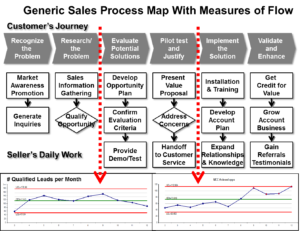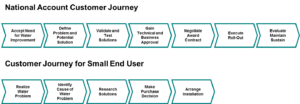SPIF Tip #52: How Do You Map A Sales Process?
 Mapping a sales process (or designing it) is pretty simple, at least at first. The key is to recognize at all times that your goal always involves helping customers take the actions they want to take. With that as the “North Star,” finding your path through the woods is much easier.
Mapping a sales process (or designing it) is pretty simple, at least at first. The key is to recognize at all times that your goal always involves helping customers take the actions they want to take. With that as the “North Star,” finding your path through the woods is much easier.
- Prepare to map the process.Despite the stories about salespeople out on the road independently, sales is actually a team sport. Salespeople try to get customers on their team, for example. And they require support from marketing or servicing departments, to give the customer what they want.
If you want the performance of this team to improve, you have to get them all on the same page. Heck, many of salespeople’s most crucial problems occur because they are not on the same page with the customer, the support departments, or with each other. So, this shouldn’t be too hard.
Of course, this might be difficult if you adhere to old-fashioned management notions that pit salespeople against each other. However, if you have gotten beyond that issue, you can start getting your team to think about what their biggest challenges are, and the reasons for those challenges. There will be lots of opinions, and this is one of the main reasons to “map” the process. Your team needs to understand what they will get out of this. What is going to be different afterwards? What does it involve?
The answers to these questions are always unique to your particular situation, but they involve things like:
- Figuring out what causes variations in salespeople’s performance, and enabling salespeople to learn from each other.
- Getting a handle on which deals are most likely to close and which ones aren’t, so salespeople can forecast more accurately.
- Standardizing language in order to understand (with data rather than opinions) what factors cause the most challenges for salespeople, so you can try to improve the situation.
You should tell them that one of the goals is to achieve “respectful agreement” around the best way to accomplish their objectives, so that as a team they can learn from their experiences, and share important data about how we do the work with management, so they can start helping each other improve.
Another goal is to ensure that your team is executing the work in the most professional and expeditious manner possible. There are always things to improve on, and a process is all about making improvements.
- Identify the customer’s journey.You or your salespeople may know this already, and that is fine. If they don’t know, or if there are disagreements, that has to be sorted out first. Sometimes prospects buy differently if they are in different market segments (e.g., big companies instead of small companies), or if they are buying different kinds of products and services (replacement of supplies instead of deciding to change their internal systems). Also, sometimes, it pays to actually ask some of your prospects about this. It can be quite an interesting conversation.
Whatever the case, you need to isolate one primary market segment that buys a similar thing in a similar fashion. Draw the stages your prospects go through in sequence on a whiteboard. Here are two examples of customer journeys from different kinds of industries:
A key thing is to make sure your team is clear on the operational definition of each stage. In other words, what observable customer activity or action tells you they are in one stage or another? This is key, because for a process map to work, salespeople must be able to rely on these observations.
For example, people often point out that customers can go backward in this progression. A National Account can go from “Gain Technical and Business Approval” (step four) back to “Accept the Need for Water Improvement” (step one). A Small End User can go from “Research Solutions” to “Identify Cause of Water Problem.” However, what this really means is that only some individuals within the customer were at those stages and they failed to get their organization to follow. The real question is what can you observe that demonstrates the entire organization (i.e., the decision maker) is at one stage or another. This is where the real sales strategy comes in.
- Identify The Work That Aligns With The Customer Journey.Now we are getting somewhere. This is the part of process mapping that often generates the most learning and discussion. What, exactly, does your company do to identify where prospects really are in their journey, and then get to the next step? It is likely that your team has never thought of their sales process systematically before, so you can expect some struggles as people realize how differently they approach these various stages. There will be gaps and inconsistencies. The thing is, since everyone does so many things differently, just achieving a common language and common ground on how to think about the process usually produces major improvements.Of course, each company’s particular process will be vastly different. However, sometimes it helps to examine a model of how it should look. Below is a model of what you are shooting for. It includes the Customer Journey, a name for each of the work steps aligned with the Customer Journey stages, and indicates the thresholds where the flow of sales opportunities can be measured.

- Manage the Process Using the Process MapBear in mind the diagram above is ideal because it frames the realities the sales organization has to deal with. Ignore the customer journey by pushing demos or samples on companies who have not agreed they need your product? Good luck with that. Salespeople having difficulty finding enough qualified opportunities? No amount of discounts or special promotions will solve such problems. This is not process for process sake. Far from it. The value of this map is to help everyone see where the problems are, so they can apply the right kind of work to solve it. And, solve it in a measurable way, I might add.When you begin to take this approach, there will be some breakthroughs where things turn out easier than you expect. For example, I worked with a sales organization of about 36 people, where to everyone’s surprise several of the old salts hugely supported the newly designed approach. However, you will also find some things to be harder than you expect. In that same organization, many of the salespeople came from clinical rather than professional selling backgrounds. It took time for some of them to get used to some terms for buying roles like coaches and gatekeepers, or end users and decision makers.For this reason, it can take a while before your sales process resembles the ideal shown in the diagram. That is fine, because the purpose of a process map – indeed the entire process approach to business – is to increase your team’s knowledge of the best ways to do the work. We all think we understand more than we actually do.A process approach forces us to be humble, and to write down our beliefs about how the work should be done and what the outcomes will be. Then, by actually doing it you learn how things really work, which usually isn’t according to plan. In fact, the ability to learn, and most importantly to change based on what they have learned is what separates great companies from merely good ones.
Conclusion
It is quite a major accomplishment to go from the usual helter-skelter of professional selling to having respectful agreement around a professionally mapped B2B sales process. Just as all maps must orient to some kind of “North Star,” your organization’s process map helps everyone on your team to orient toward your customer.
Along the way, you’ll elevate the professionalism and effectiveness of your sales team. That’s because you will learn a consistent way to identify and prioritize the right accounts. The team stops wasting effort on demonstrations and proposals to customers who aren’t ready, or won’t ever buy. Data from their activities effectively reveals bottlenecks in the flow of business, informing managers where they might need to focus. Some company leaders learn they can’t make their sales numbers without improving how they handle customer service. Others realize the sales department needs help finding enough qualified sales opportunities. Still others realize revenue gains immediately, as blockages are removed from deal flow.
A process enables leaders and managers to help their people develop a common language around the realities they face, and establish goals that align with customer needs. When this happens, close ratios improve. Cycle times shorten. Productivity often increases by 50% or more. And that is the point of creating a process map. It enables everyone to discover the evidence and data required to find the breakthroughs everyone is hoping for.
Good luck with your sales process mapping efforts.
And, good selling!


